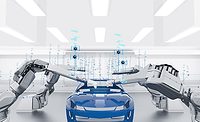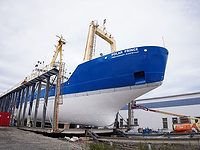The Next Big Thing in Robotic Painting: Smart Atomizers




In most manufacturing and production facilities, defective or poor-quality products can be detected only after the vehicle has been fully painted. In simple processes, an operator identifies the quality issue and takes action. With the addition of basic sensors, some paint-quality defects can be prevented from happening. The system can sound an alert or alarm and the process stopped until technicians correct the issue before the painting proceeds. The most-efficient and capable processes include real-time sensing that detects component quality issues as they occur. That information is immediately fed back via a control loop to the process. Action is taken instantly to correct the process issue, minimizing or completely avoiding scrap and rework.
In automated painting systems, unsatisfactory paint application has long been detected only after the fact; a downstream inspection identified defects in the job. How far downstream that inspection occurs determines the number of poorly painted parts and the amount of rework or scrap created. Today, digitalization of the paint application process is changing that scenario with a smart atomizer for robotic paint lines that can virtually eliminate improperly painted parts and the resulting rework.
Digitalizing Atomizers
A wide range of manufacturing and industrial processes have already been vastly improved by incorporating intelligence in the production assets. A variety of sensors, whether embedded in or added onto production devices, provide feedback about the operational status and health of these assets. Sensors are available to monitor a range of the devices’ “vital signs” – parameters like temperature, flow, vibration, pressure and more.
“ABB is the first to introduce connected atomizers with smart sensors embedded in the robotic painting automation industry,” explains Ray Li, Technology Excellence Manager in ABB’s Robotics Business Unit. “Now, instead of identifying problems with the painting processes based on poor results, it’s possible to prevent some of them from occurring. These smart, connected atomizers monitor the condition of key atomizer components to potentially eliminate rework due to atomizer-related problems.”
The ABB Ability™ connected atomizer, RB1000i, includes multiple sensors, each providing unique feedback regarding the status or health of the atomizer and the painting process.
- Gyro: measures the movement and angular acceleration of the robot arm at the atomizer. This data can be used to ensure that target acceleration limits are exceeded, and avoid air motor damage due to high re‑orientation speed.
- Vibration sensor: provides a warning if the Bell cup becomes unbalanced, a situation leading to improper paint application. The vibration sensor can also identify damage to the air motor.
- Temperature sensor: monitors compressed air temperature and optimizes consumption of exhausted air, preventing water condensation.
In addition to enabling near-zero-defect painting, the sensors also can also reduce wasted paint and production time. During paint-line startup, the atomizer can self-diagnose operational readiness rather than test painting several samples to assess paint line status prior to beginning production. The equipment integrity check function is to allow the operator to perform an automatic functionality check including asset ID check, bell vibration check, paint cavity check and fiber quality check
Adding to the “active” forms of intelligence, the digitalized atomizer also includes “passive” intelligence in the form of RFID tags attached to key replaceable components: the bell cup, SA nozzle and air turbine. The robot arm needs only bring the atomizer within range of the nearby RFID reader to confirm that the correct components are in place for the current painting task. The tags also make the key parts traceable and incorporate them in the equipment’s smart life cycle management, enabled by machine learning technology at cloud, as the next step.
Putting the Data to Work
Adding intelligence to production lines enables a range of possible process-control options. Process operators may rely on this data to simply trigger alarms, alerting operators when a threshold has been crossed so they can explore and, if necessary, correct the issue. More sophisticated systems rely on analytics to gather and assess data from one or more sensors. Based on those analytics, the process can be adjusted, whether manually or automatically, or the appropriate maintenance activities initiated.
“The RB1000i feeds sensor data to the ABB RobView software, says Ray. “The software processes the data, making the output available locally to the line operator. Of course, that process data can also be fed upward to larger analytics platforms that encompass all aspects of the process, creating a connected service platform for an entire robotic painting line. Besides giving a holistic view of the process in real time, the data can also provide the basis for process analysis.
Acceleration, pressure, vibration and temperature data can be correlated to paint-transfer efficiency. Robotic painting can be optimized in ways never before possible.”
Painting a Digital Future
Atomizers are remarkable, but are complex and sensitive devices. The ABB Ability Connected Atomizer is the first connected, sensor-equipped robotic paint atomizer. Digitalizing atomizers – equipping them with sensors and connecting them to systems able to monitor and assess their function and health – is making it possible to automatically ensure that they are functioning correctly and producing only properly painted parts.
“Production-scale component painting has advanced greatly from the days when it was a hands-on task with poorly controlled quality,” Ray says. “Automation has vastly increased both throughput and consistency. Atomizer digitalization represents another significant step forward in process improvement, reducing defects, enhancing productivity and increasing paint utilization.
Automated painting lines in Asia and Europe have been applying this technology to take their facilities to the next level of operational optimization.
For more information, visit www.abb.com/robotics.
Looking for a reprint of this article?
From high-res PDFs to custom plaques, order your copy today!








